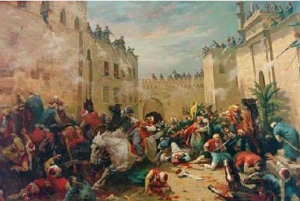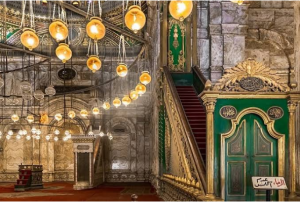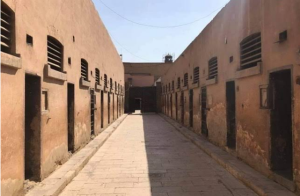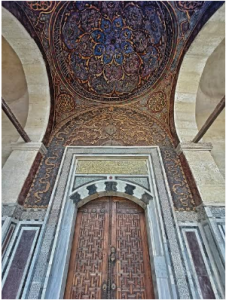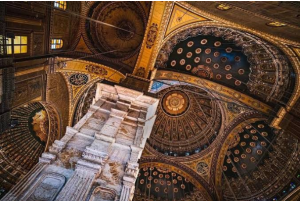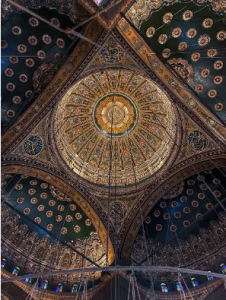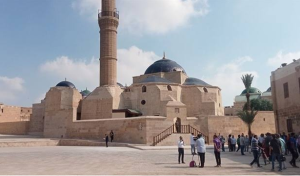Citadel of Cairo (Part I)
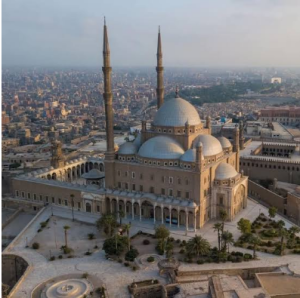
The Citadel of Salah al-Din al-Ayyubi
As we know, Muhammad Ali Pasha faced many difficulties, including the Mamluk leaders. Therefore, he set up a trap and a deception to get rid of them. He held a special party to bid farewell to Prince Ahmad Tosun from the Citadel of Salah al-Din al-Ayyubi and sent him to the Hijaz to suppress the Wahhabi movement. Therefore, Muhammad Ali Pasha invited the state’s senior officials and their leaders. Here, Muhammad Ali Pasha cunningly planned this massacre to get rid of the Mamluk leaders. At the end of the military parade and their exit from the citadel, the door was closed on the last group, which was the Mamluks, and he got rid of them all by shooting them. Muhammad Ali Pasha is considered one of the most important and famous kings of Egypt throughout its history. He was one of the Ottoman Albanian soldiers, born in 1796 in the town of Kavala. He worked in trade and selling tobacco, which is why he is known as the father of tobacco in Egypt. Then he joined the Ottoman army that came to Egypt to expel the French campaign. He succeeded in this and gained great fame. After that, he became one of the most important military men in Egypt. In July 1805, the senior people of the Egyptian nation pledged allegiance to him to be their ruler. With his assumption of power, he paid attention to modern sciences and various fields of education. He also built many schools. Therefore, he is rightfully considered the man of the renaissance in modern Egypt.
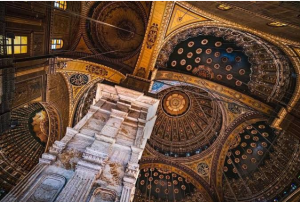
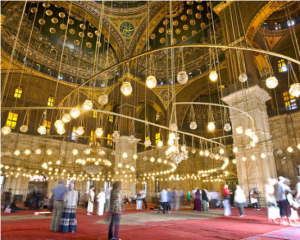 Salah al-Din al-Ayyubi is the founder of the Ayyubid dynasty. His real name is Yusuf, but Salah al-Din is only a title. He was born in Tikrit in a Kurdish family. He read and memorized the Quran and many hadiths, and he trained in military sciences and loved jihad. He began establishing the Ayyubid states, uniting the Arab Muslim regions such as the Hijaz, Yemen, and Egypt under the banner of the Abbasid Caliphate. He also eliminated the Shiite Fatimid Caliphate in Egypt. In addition, he led many military operations and campaigns against the Crusaders in the Middle East. He achieved many victories, and perhaps the expulsion of the Crusaders from Acre is one of his most famous victories. Therefore, European historians have spoken about him a lot and were baffled by his military war plans. Therefore, the commander Salah al-Din al-Ayyubi is a symbol of chivalry and bravery. We would also like to clarify that he built many Sunni schools and many khanqahs, which are places where their owners are only engaged in worship throughout the day.
Salah al-Din al-Ayyubi is the founder of the Ayyubid dynasty. His real name is Yusuf, but Salah al-Din is only a title. He was born in Tikrit in a Kurdish family. He read and memorized the Quran and many hadiths, and he trained in military sciences and loved jihad. He began establishing the Ayyubid states, uniting the Arab Muslim regions such as the Hijaz, Yemen, and Egypt under the banner of the Abbasid Caliphate. He also eliminated the Shiite Fatimid Caliphate in Egypt. In addition, he led many military operations and campaigns against the Crusaders in the Middle East. He achieved many victories, and perhaps the expulsion of the Crusaders from Acre is one of his most famous victories. Therefore, European historians have spoken about him a lot and were baffled by his military war plans. Therefore, the commander Salah al-Din al-Ayyubi is a symbol of chivalry and bravery. We would also like to clarify that he built many Sunni schools and many khanqahs, which are places where their owners are only engaged in worship throughout the day.
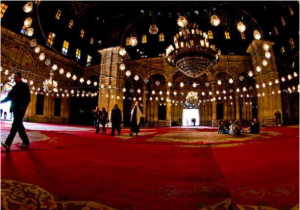 As for the copper clock tower, it was a gift from the French King Philip Louis to Muhammad Ali. It was inside a university in exchange for a huge obelisk that is now in the middle of the Place de la Concorde in France. We see that the clock tower is made of decorated copper with plant and geometric decorations. It is currently under maintenance and restoration. As we know, this tower was used to call for prayers in the Muhammad Ali University in the Citadel.
As for the copper clock tower, it was a gift from the French King Philip Louis to Muhammad Ali. It was inside a university in exchange for a huge obelisk that is now in the middle of the Place de la Concorde in France. We see that the clock tower is made of decorated copper with plant and geometric decorations. It is currently under maintenance and restoration. As we know, this tower was used to call for prayers in the Muhammad Ali University in the Citadel.
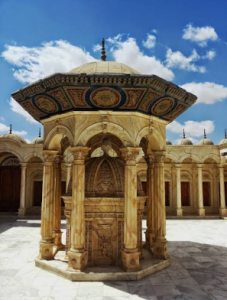
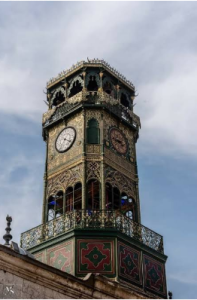
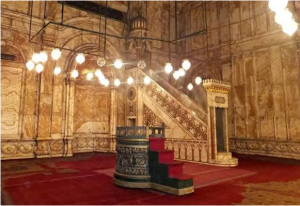
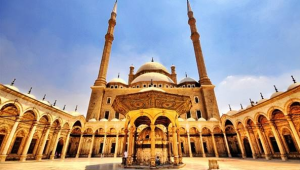 The Citadel of Salah al-Din al-Ayyubi was built more than 873 years ago by the founder of the Ayyubid dynasty, Salah al-Din al-Ayyubi, who is considered one of the most respected figures in the Islamic world and one of the greatest Muslim leaders in the Islamic world. Salah al-Din al-Ayyubi asked his vizier, Baha’ al-Din Qaraqosh, to build this great citadel to protect the city of Cairo and other cities such as al-Askar, al- Qataie, and Fustat. He chose the location well as a defensive citadel due to its high elevation and proximity to the impregnable Mount Moqattam, and he chose the suitable weather for the life of soldiers. Some historians mention that Salah al-Din inquired about the weather of the citadel’s location before building it, whether it was suitable for the soldiers’ lives. He conducted a test with a piece of meat, leaving it for a period of time until it spoiled. Indeed, the piece spoiled after four days, which was a good test that the location was very suitable and healthy for the soldiers’ lives.
The Citadel of Salah al-Din al-Ayyubi was built more than 873 years ago by the founder of the Ayyubid dynasty, Salah al-Din al-Ayyubi, who is considered one of the most respected figures in the Islamic world and one of the greatest Muslim leaders in the Islamic world. Salah al-Din al-Ayyubi asked his vizier, Baha’ al-Din Qaraqosh, to build this great citadel to protect the city of Cairo and other cities such as al-Askar, al- Qataie, and Fustat. He chose the location well as a defensive citadel due to its high elevation and proximity to the impregnable Mount Moqattam, and he chose the suitable weather for the life of soldiers. Some historians mention that Salah al-Din inquired about the weather of the citadel’s location before building it, whether it was suitable for the soldiers’ lives. He conducted a test with a piece of meat, leaving it for a period of time until it spoiled. Indeed, the piece spoiled after four days, which was a good test that the location was very suitable and healthy for the soldiers’ lives.
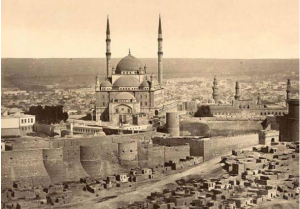 The Citadel of Salah al-Din al-Ayyubi is not merely large walls and towers. You can enjoy visiting and seeing its beautiful remains, such as its massive gates and more than three palaces like the Jewel Palace, and you can visit four mosques inside the citadel, such as the Mosque of Muhammad Ali and the Mosque of Sariya al-Jabal. You can also get information about the Blood Passage and the massacre of the Mamluks. You can also visit the largest water well in Egypt, with a depth of 92 meters. You will also see many old factories, military factories, the coinage House or central bank, the justice palace, the citadel prison, and many other places inside the Citadel of Salah al-Din.
The Citadel of Salah al-Din al-Ayyubi is not merely large walls and towers. You can enjoy visiting and seeing its beautiful remains, such as its massive gates and more than three palaces like the Jewel Palace, and you can visit four mosques inside the citadel, such as the Mosque of Muhammad Ali and the Mosque of Sariya al-Jabal. You can also get information about the Blood Passage and the massacre of the Mamluks. You can also visit the largest water well in Egypt, with a depth of 92 meters. You will also see many old factories, military factories, the coinage House or central bank, the justice palace, the citadel prison, and many other places inside the Citadel of Salah al-Din.
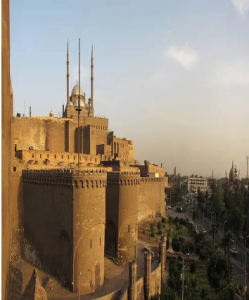 Since the citadel was a fortified place, all the kings since the Mamluk, Ayyubid, and Ottoman eras, until the Muhammad Ali family, ruled Egypt from the Citadel of Salah al-Din al-Ayyubi. It is a symbol of rule and contains the presidential palace. Therefore, the general public was not allowed to visit or see what was inside the citadel. In addition, Napoleon Bonaparte, the French commander during the French campaign, also ruled Egypt from the Citadel of Salah al-Din, and the British officers during the British occupation of Egypt also ruled Egypt from the Citadel of Salah al-Din al-Ayyubi.
Since the citadel was a fortified place, all the kings since the Mamluk, Ayyubid, and Ottoman eras, until the Muhammad Ali family, ruled Egypt from the Citadel of Salah al-Din al-Ayyubi. It is a symbol of rule and contains the presidential palace. Therefore, the general public was not allowed to visit or see what was inside the citadel. In addition, Napoleon Bonaparte, the French commander during the French campaign, also ruled Egypt from the Citadel of Salah al-Din, and the British officers during the British occupation of Egypt also ruled Egypt from the Citadel of Salah al-Din al-Ayyubi.
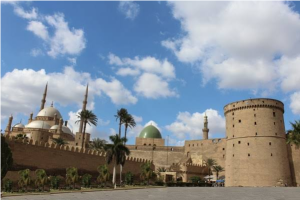 The Citadel of Salah al-Din al-Ayyubi played an important role in the history of the Egyptians for hundreds of years. Unfortunately, the citadel was subjected to many fires and explosions throughout its history. The citadel was subjected to three consecutive fires in the Mamluk era twice and once in the Ottoman era. The citadel also witnessed two severe explosions during the period of Muhammad Ali Pasha, as he built factories for the manufacture of dynamite for the cannons that the citadel produced. These explosions led to the destruction of many ancient artifacts.”
The Citadel of Salah al-Din al-Ayyubi played an important role in the history of the Egyptians for hundreds of years. Unfortunately, the citadel was subjected to many fires and explosions throughout its history. The citadel was subjected to three consecutive fires in the Mamluk era twice and once in the Ottoman era. The citadel also witnessed two severe explosions during the period of Muhammad Ali Pasha, as he built factories for the manufacture of dynamite for the cannons that the citadel produced. These explosions led to the destruction of many ancient artifacts.”
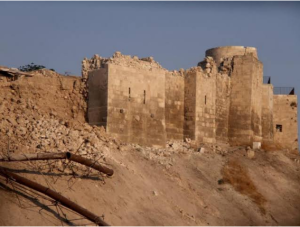 The Citadel of Salah al-Din al-Ayyubi witnessed many decisions and many events. However, the decision and event related to the massacre of the Mamluks carried out by Muhammad Ali Pasha, the ruler of Egypt, where he killed more than 470 Mamluk leaders, remains the most difficult and bloodiest. You can see this corridor, as it is a living witness to this violent massacre
The Citadel of Salah al-Din al-Ayyubi witnessed many decisions and many events. However, the decision and event related to the massacre of the Mamluks carried out by Muhammad Ali Pasha, the ruler of Egypt, where he killed more than 470 Mamluk leaders, remains the most difficult and bloodiest. You can see this corridor, as it is a living witness to this violent massacre
